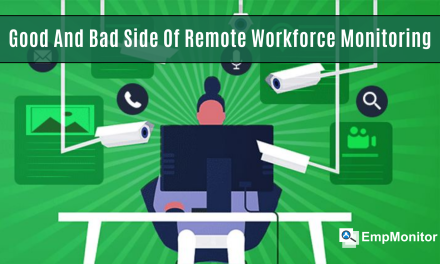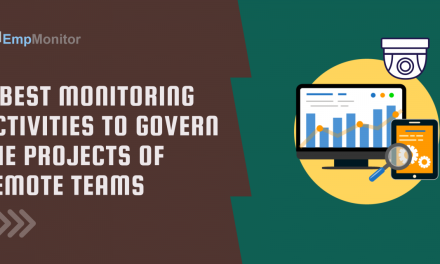In today’s fast-paced business world, workplace productivity is a crucial factor that can make or break a company’s success.
As organizations strive to optimize their operations on a day-to-day basis, employee monitoring software has emerged as one of the most powerful tools they can use to enhance their productivity levels.
In addition to providing insight into employee activities, performance, and task management, these tools have enabled businesses to manage their workforce more effectively.
In this blog, we will explore the need for employee monitoring software, how to implement an efficient employee tracking program and the numerous benefits it brings to the table.
Listen To The Podcast Now!
Need For Employee Monitoring Software
Employee monitoring software has become increasingly essential for businesses due to several reasons:
1. Productivity Enhancement: Monitoring software allows employers to track employee activities, helping identify and rectify time wastage ensuring optimal productivity.
2. Performance Evaluation: Employers can accurately evaluate individual and team performance by monitoring tasks and projects.
3. Security and Data Protection: Monitoring tools can detect and prevent unauthorized access to sensitive information, safeguarding the company’s data and preventing breaches.
4. Compliance and Legal Requirements: Monitoring helps organizations adhere to industry regulations and legal standards by ensuring employees adhere to rules and regulations.
5. Remote Work Monitoring: With the rise of remote work, monitoring software aids in keeping remote employees on track and maintaining collaboration and communication.
6. Identifying Training Needs: Employers can identify gaps in employee abilities by analyzing their workflows.
7. Preventing Insider Threats: Monitoring software can detect unusual behavior patterns that might indicate insider threats or unethical activities.
8. Resource Allocation: Insights gained from monitoring can aid in effective resource allocation, improving project management and reducing wastage.
9. Task Prioritization: Monitoring tools help to know where employees spend their time, facilitating better task prioritization for improved efficiency.
10. Open Communication: Use of monitoring software promotes open communication between management and employees, fostering trust and understanding.
Employee monitoring software offers multifaceted advantages, ranging from productivity boosts and performance evaluation to security reinforcement and legal compliance. Its relevance continues to grow as work environments evolve, making it a crucial tool for modern businesses.
How To Run An Efficient Employee Tracking Program?
Running an efficient employee tracking program involves several key steps to ensure its effectiveness:
1. Implementing Employee Monitoring Software:
- Choose a reliable monitoring software that aligns with your company’s needs and values.
- Select features that allow you to track tasks, time spent, and project progress while respecting employee privacy, just like EmpMonitor.
EmpMonitor is a best employee monitoring software offering a variety of features that can improve your workplace productivity.
Some of its features are:
Time-Tracking – EmpMonitor’s time tracking feature offers precise monitoring of employee work hours and activities, enhancing productivity and enabling efficient time management within organizations.
Attendance Monitoring – The attendance monitoring feature ensures accurate recording of employee attendance, streamlining payroll processes and promoting accountability in the workplace.
Data Security – This feature employs robust encryption and access controls, safeguarding company data and avoiding data theft.
Geo Location Tracker – The Geo-location tracker feature tracks employee locations, aiding remote work management and ensuring compliance with location-based requirements.
Data Loss Prevention – Data loss prevention features seamlessly block unauthorized websites and restrict access with website blocking, application blocking and USB detection.
2. Clear Communication and Transparency:
- Inform employees about the implementation of monitoring software and the reasons behind it.
- Emphasize that the software aims to improve productivity, collaboration, and data security, not to invade privacy.
3. Set Clear Objectives:
- Define the goals of the tracking program, such as boosting productivity, identifying bottlenecks, or enhancing remote work management.
4. Customized Tracking Parameters:
- Tailor the monitoring software to focus on relevant metrics and activities specific to your industry and organization.
5. Respecting Privacy and Data Protection:
- Ensure the software complies with data protection laws and respects employees’ privacy rights.
- Anonymize or aggregate data where possible to maintain individual privacy.
6. Training and Onboarding:
- Provide comprehensive training to employees on how the monitoring software works and how it benefits both the company and individuals.
7. Regular Performance Feedback:
- Use the data collected to provide constructive feedback to employees about their performance, emphasizing strengths and areas for improvement.
8. Recognize and Reward:
- Use the insights gained from monitoring to identify high-performing employees and acknowledge their efforts and achievements.
9. Continuous Improvement:
- Regularly assess the effectiveness of the tracking program and make adjustments based on feedback from employees and managers.
10. Balancing Accountability and Trust:
- Maintain a balance between holding employees accountable for their work and fostering a trusting work environment.
By following these steps, you can run an efficient employee tracking program that promotes productivity, enhances communication, and respects the well-being and privacy of your workforce.
Also Read
Top 5 Solid Reasons For User Activities Monitoring
How To Improve Productivity And Efficiency With Time Management Software?
What Is The Best Employee Computer Monitoring Software You Can Use?7 Onboarding Best Practices That Can UpSkill The Employee Experience
Benefits Of Employee Monitoring Software
Employee monitoring software offers numerous benefits for both employers and employees. Here are some key advantages, with additional explanations to highlight their significance:
1. Increased Productivity:
Employee monitoring software serves as a valuable tool for identifying time-wasting activities within the workplace. By pinpointing these inefficiencies, employees are encouraged to manage their time more effectively and maintain better focus on their tasks. This, in turn, leads to increased overall productivity, benefiting both individual employees and the organization as a whole.
2. Enhanced Accountability:
By implementing monitoring software, employers can closely track employees’ work hours and tasks completed. This fosters a sense of responsibility among employees, reducing the likelihood of procrastination and unproductive behavior. The increased accountability creates a more efficient work environment.
3. Improved Efficiency:
Staff monitoring software not only tracks employee activities but also helps identify workflow bottlenecks. Recognizing these inefficiencies enables organizations to optimize processes and allocate resources more effectively, ultimately improving overall efficiency and productivity.
4. Data Security:
This kind of monitoring software plays a crucial role in guarding against data breaches and unauthorized access. It acts as a safeguard for sensitive company information and client data, ensuring the security and integrity of the organization’s digital assets.
5. Fair Performance Evaluation:
This type of software provides objective and data-driven insights for performance assessments. It enables employers to make fair decisions regarding rewards and promotions, basing them on measurable achievements rather than subjective judgments.
6. Remote Work Support:
In an era of remote work, monitoring software assists in effectively managing remote teams by tracking their activities. This ensures that remote employees remain connected, engaged, and productive, even when working from different locations.
7. Legal Compliance:
The software helps businesses adhere to labor laws and regulations by recording employee activities. This proactive approach aids in preventing workplace harassment and discrimination, fostering a more inclusive and compliant work environment.
8. Project Management:
Monitoring software serves as a valuable tool for keeping tabs on project progress and deadlines. It aids in the efficient allocation of resources to ensure the successful completion of projects, contributing to the overall success of the organization.
9. Cost Savings:
By identifying areas of excessive expenditure, staff monitoring software helps organizations optimize resource allocation and reduce unnecessary expenses. This leads to significant cost savings and a more efficient budget management process.
10. Employee Development:
The software identifies training needs and areas for improvement among employees. This data-driven approach contributes to the development of skills and the growth of individual employees, ultimately enhancing the organization’s workforce.
11. Transparent Communication:
Employee monitoring software promotes open and honest communication between employers and employees. Transparent communication builds trust and fosters a positive workplace culture, leading to improved collaboration and employee satisfaction.
12. Work-Life Balance:
Monitoring workload through this software helps prevent employee burnout by ensuring a manageable and equitable distribution of tasks. This proactive approach encourages a healthier work-life balance among employees, improving their overall well-being and job satisfaction.
Conclusion
Employee performance tracking software has transitioned from being viewed as a surveillance tool to being recognized as a strategic asset for enhancing workplace productivity.
By addressing the need for accountability, fostering open communication, and leveraging data-driven insights, organizations can create an environment that empowers employees to excel.
When implemented thoughtfully and ethically keeping in mind all the pros and cons of employee monitoring this software paves the way for a more efficient, productive, and successful workforce.














